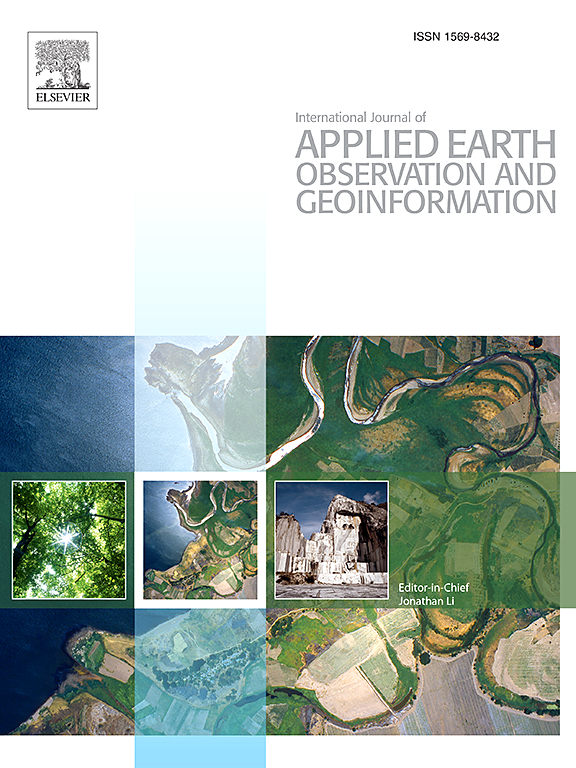PROSPECT-DP:一种耦合叶片光学特性模型,通过排除ChlF效应来改善红边域叶片光谱模拟
IF 8.6
Q1 REMOTE SENSING
International journal of applied earth observation and geoinformation : ITC journal
Pub Date : 2025-06-07
DOI:10.1016/j.jag.2025.104651
引用次数: 0
摘要
大量的叶片光谱数据集已被用于叶片光学模型或经验模型的校准和验证。然而,目前还没有实验在分离叶绿素荧光(ChlF)贡献的同时测量叶片的真实反射率和透射率光谱,这对测量的反射率或透射率产生了叠加效应。因此,由于没有用于叶片模型校准的真实叶片光谱,到目前为止,叶片光谱在红边域的模拟精度仍然有限。本研究旨在将现有的叶片物理模型(PROSPECT-D)与通常用于建立叶片经验模型的数据驱动方法相结合,提高在红边域模拟叶片光谱特征的精度。在建模过程中,首先测量了一个新的叶片光谱数据集,包括849片叶片的反射率和透射率数据,并取代了现有的叶片光谱数据集。建立了叶片光学特性耦合模型(PROSPECT-DP),该模型采用主成分分析(PCA)方法,利用训练数据集得到的光谱向量对红边域的叶片光谱进行建模,利用PROSPECT-D模拟的除红边域外的叶片光谱确定光谱向量系数。最后,利用203个叶片样本的独立验证数据集对PROSPECT-DP模型进行验证,结果表明,该模型在红边域的光谱模拟效果明显优于PROSPECT-D模型。此外,与PROSPECT-D模型相比,PROSPECT-DP模型在叶片性状反演中表现出更好的性能,测量和PROSPECT-DP衍生的叶片叶绿素a + b和类胡萝卜素之间的关系更密切。因此,本研究提出的叶片耦合模型将有利于叶片模型与冠层模型的整合,并可用于植物性状的遥感评估。本文章由计算机程序翻译,如有差异,请以英文原文为准。
PROSPECT-DP: A coupled leaf optical properties model for improving leaf spectra simulation in the red-edge domain by excluding the ChlF effect
Plenty of leaf optical spectra datasets have been employed in the calibration and validation of leaf optical or empirical models. However, no experiment has been conducted that measures the true leaf reflectance and transmittance spectra while isolating chlorophyll fluorescence (ChlF) contributions, which results in a superimposed effect on measured reflectance or transmittance. As a result, to date, the simulated accuracy of leaf spectra in the red-edge domain remains limited due to the absence of true leaf spectra used in calibration of leaf models. This study aims to enhance the accuracy of simulating leaf spectral characteristics in the red-edge domain by combining an existing leaf physical model (PROSPECT-D) with the data-driven method that is typically used to establish leaf empirical models. A new leaf spectra dataset without ChlF contributions, including reflectance and transmittance data for 849 leaves, was first measured and replace the existing leaf spectra datasets in the modelling process. A coupled leaf optical properties model (PROSPECT-DP) was then established, in which a principal component analysis (PCA) approach was employed to model leaf spectra in red-edge domain using the spectral vectors derived from the training dataset, while the coefficients of spectral vectors were determined by leveraging the PROSPECT-D simulated leaf spectra except for the red-edge domain. Finally, validation of the PROSPECT-DP model with an independent validation dataset of 203 leaf samples showed that it performed much better than the PROSPECT-D model for spectral simulation in the red-edge domain. Furthermore, the PROSPECT-DP model exhibited better performance in leaf trait inversions with a closer relationship between measured and PROSPECT-DP-derived leaf chlorophyll a + b and carotenoid pigments compared to the PROSPECT-D model. Therefore, the novel coupled leaf model presented in this study will be highly beneficial for the integration of leaf models into canopy models and for applications in remote sensing to assess plant traits.
求助全文
通过发布文献求助,成功后即可免费获取论文全文。
去求助
来源期刊

International journal of applied earth observation and geoinformation : ITC journal
Global and Planetary Change, Management, Monitoring, Policy and Law, Earth-Surface Processes, Computers in Earth Sciences
CiteScore
12.00
自引率
0.00%
发文量
0
审稿时长
77 days
期刊介绍:
The International Journal of Applied Earth Observation and Geoinformation publishes original papers that utilize earth observation data for natural resource and environmental inventory and management. These data primarily originate from remote sensing platforms, including satellites and aircraft, supplemented by surface and subsurface measurements. Addressing natural resources such as forests, agricultural land, soils, and water, as well as environmental concerns like biodiversity, land degradation, and hazards, the journal explores conceptual and data-driven approaches. It covers geoinformation themes like capturing, databasing, visualization, interpretation, data quality, and spatial uncertainty.
 求助内容:
求助内容: 应助结果提醒方式:
应助结果提醒方式:


